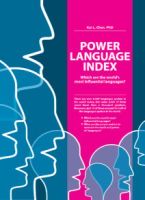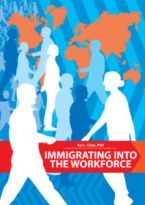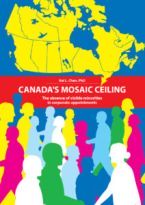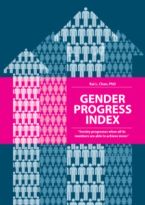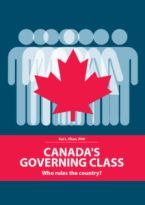
Toronto Star article: “Parliament’s lack of diversity goes beyond race, gender: study”
January 2, 2015
Parliament’s lack of diversity goes beyond race, gender: study
A study exploring the demographics of Parliament suggests a mismatch with the Canadian population that goes beyond race and gender to issues such as religion and education.

The ruling Conservatives and federal cabinet don’t look remotely close to the new Canada they represent, says a new study, which suggests there are real consequences to the lack of diversity.
Kai L. Chan’s demographic study of who’s representing us in Parliament shows that the federal NDP comes closest to matching Canada’s visible-minority and gender realities, but both the House of Commons and Senate fail miserably in mirroring the diversity of Canada.
“The socio-demographic biases are not without consequence as Parliament is the policy-making and political governing body of the country,” Chan writes in “Canada’s Governing Class: Who rules the country?”
“When these decision makers debate the merits of initiatives, laws or policies that affect . . . women, minorities or the scientific community, the opinions of Parliament are likely to be uninformed and/or not reflective of the general population.”
Chan, a Torontonian working in Dubai as a policy adviser to the prime minister of the United Arab Emirates, says he doesn’t belong to any Canadian political party but has always been interested in diversity representation in politics.
His study includes less commonly discussed factors such as the representation of religious beliefs, educational background and official language competency among Canada’s political elites.
Chan said his study was prompted by curiosity about the tensions between the governing Conservatives and Canada’s scientific community. He wondered how many MPs came to the job with an academic background in the sciences, and then decided to expand the scope of his research to other areas.
Despite their image as coming from the elite, Chan found Conservative parliamentarians actually have the “lowest incidence of higher education” among the three major parties; almost one-third of Tory members in the House and Senate don’t have post-secondary credentials.
“Along the party lines, the Liberals are the most highly educated, and they have the highest uptake in law (33.3 per cent) and doctoral-level degrees (17.5 per cent),” said Chan, who has a bachelor’s degree from the University of Toronto and a PhD in economics from Princeton University.
“The percentage of parliamentarians with science and engineering degrees (13 per cent) is abysmally low, but there is no shortage of people with arts degrees (73.3 per cent) in Parliament.”
Chan’s findings are based on information found on the official and personal websites of MPs and senators, as well as other publicly available data.
As of September, there were 307 MPs (one vacant), including 162 Tories, 97 NDPs and 37 Liberals. In the Senate, there were 54 Conservatives, 30 Liberals and seven independents, with 14 seats unfilled.
Nationally, women and visible minorities respectively represent 50 per cent and 23.3 per cent of the population; some 22.6 per cent of Canadians can speak French.
In total, women made up only 27.6 per cent of the House and Senate, while visible minorities accounted for 12.3 per cent of the two bodies. Only the ratio of French-speaking politicians is at par with the national average.
Among the three parties, the Tories fared the worst in women’s representation; only 21.8 per cent of its members were female, compared with 36.1 per cent for the NDP and 31.3 per cent for the Grits.
Similar patterns followed, the report said, with visible minorities, who made up 10.2 per cent of the Tory members, 14.4 per cent of the NDP and 13.4 per cent of the Liberals.
“The heavily-populated provinces also happen to be home to the majority of immigrants and minorities, with over half (52.4 per cent) of immigrants and close to half (46.7 per cent) of minorities in Ontario alone,” said the study.
“It seems logical that the under-allocation of seats to Ontario in the House is at least one factor in the under-representation of minorities in the Parliament. This bias is likely amplified when considering that BC and Alberta — two other underrepresented provinces — are also magnets for minorities and immigrants.”
NDP members who call Calgary or Edmonton their hometown outnumber Conservatives who do, despite the Tory power base in the western provinces. More than 10 per cent of the Tory parliamentarians have roots in Toronto, greater than the share of the Liberals (9 per cent), who are sometimes seen as a GTA-centric party.
While 88.4 per cent of the Tory MPs identified English as their preferred language, 52.6 per cent of the NDP members preferred French. The Liberals have the largest share of members (almost 12 per cent) who are comfortable in both official languages.
Another surprise in the study, Chan said, is that there were more Liberals (34.3 per cent) who publicly disclosed their religion than Conservatives (31.5 per cent). The NDP members had the lowest rate of public disclosure, at 11.3 per cent.
Younger voices are also underrepresented; the median age, 57, of the current Parliament is much older than the national median of 40.6. The representation of young voices is even more dismal in the Senate, where members’ ages average out at 67.
Chan said science, technology, innovation, and research and development are essential to sustained growth. He wonders if Canada’s underinvestment in these areas is a result of the absence of trained scientists and engineers in the government, which in turn has made science — and evidence-based decision-making — a low priority.
While it is best to attract the most capable people into politics, Chan said Canada can improve its diversity representation by following Australia and Belgium in introducing mandatory voting.
He said it would force political parties to offer a slate more aligned with the demographics of their constituencies.
Canada’s first-past-the-post ballot system leads to skewed results, in which a majority government can be elected with far less than the majority of the popular vote.
However, Chan said, under a proportional representation system votes are never wasted, as each one counts towards the eventual share of seats allocated to each party, making the governing body more representative of the people’s wishes.
Highlights
27.6: percentage of women in the House and Senate
12.3: percentage of visible minorities in Parliament
23.3: percentage of visible minorities in the population
57: median age in Parliament
40.6: national median age


